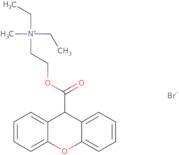Ulcine-d3 Bromide
CAS : 53-46-3
Ref. 3D-AAA05346
| 1mg | Arrêté | ||
| 5mg | Arrêté | ||
| 10mg | Arrêté | ||
| 25mg | Arrêté | ||
| 50mg | Arrêté | ||
| 100mg | Arrêté |
Informations sur le produit
- Ammonium, diethyl(2-hydroxyethyl)methyl-, bromide, xanthene-9-carboxylate
- Asabaine
- Avagal
- Banthin
- Banthine
- Banthine bromide
- Diethyl(2-hydroxyethyl)methylammonium bromide, xanthene-9-carboxylate
- Dixamone bromide
- Doladene
- Ethanaminium, N,N-diethyl-N-methyl-2-[(9H-xanthen-9-ylcarbonyl)oxy]-, bromide
- Voir d'autres synonymes
- Ethanaminium, N,N-diethyl-N-methyl-2-[(9H-xanthen-9-ylcarbonyl)oxy]-, bromide (1:1)
- Frenogastrico
- Gastric mucin
- Gastron
- Gastrosedan
- Mantheline
- Metantyl
- Metanyl
- Metaxan
- Methanide
- Methanthelinium bromide
- Methanthine bromide
- Methelina
- Mtb 51
- N,N-diethyl-N-methyl-2-[(9H-xanthen-9-ylcarbonyl)oxy]ethanaminium bromide
- Resobantin
- Sc 2910
- Ulcine
- Ulcudexter
- Uldumont
- Vagamin
- Vagantin
- Xanteline
- β-Diethylaminoethyl xanthene-9-carboxylate methobromide
Ulcine-d3 Bromide is a drug that is used to measure the metabolic rate. It is a radioactive agent that can be detected by positron emission tomography (PET) scanning. This drug is used in diagnosing bowel disease, cancer, and other diseases. The substance of this product binds to acetylcholine receptors on the detrusor muscle, which causes contraction of the bladder. Ulcine-d3 Bromide has also been shown to inhibit fatty acid synthesis and chronic bronchitis by causing contraction of the papillary muscle.





